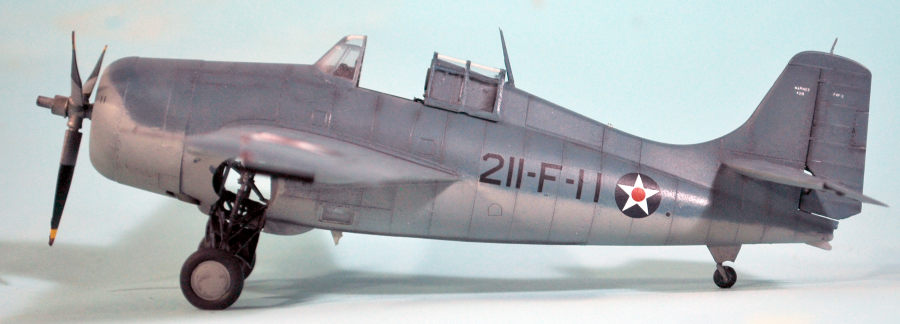
| KIT #: | 82201 |
| PRICE: | $52.95 |
| DECALS: | Six options |
| REVIEWER: | Tom Cleaver |
| NOTES: | Profipak, Yellow Wings decals |

| HISTORY |
Wake Island: Alamo of the Pacific
On Wake Island, 2,298 miles west of Honolulu and only 1,991 miles southeast of Tokyo, it was Monday, December 8, 1941 when island commander USN Cdr Winfield Cunningham received the message “Air Raid Pearl Harbor X This Is No Drill” at 0830 hours local. The American force on Wake was pitifully small: Cunningham with nine officers and 58 naval personnel who had arrived November 28; six officers and 173 men of the 1st Marine Defense Battalion who had landed on August 19, fleshed out by nine officers and 200 men who had arrived on November 5, commanded by Major James P.S. Devereux; and 11 F4F-3 Wildcat fighters detached from VMF-211, commanded by Major Paul A. Putnam which had arrived December 3, supported by 47 Marine ground support personnel from Marine Air Group 21 (MAG-21) who had been dropped off by the seaplane tender USS Wright (AV-1) on November 28.
There was a single paved runway, 5,000 feet long, so narrow that aircraft could not take off while recently-landed aircraft turned around and taxied back on the runway. The protected revetments the civilian workers had started the week before were not finished. VMF-211 was new to the Wildcat. After participating in filming the popular aviation movie “Dive Bomber” the previous spring, they traded their F3F-2s for the Wildcats in early October; the pilots had less than 20 hours’ flight experience in their new mount. None of the 47 ground support personnel were experienced airframe or engine mechanics; the two senior Gunnery Sergeants were both ordnancemen. The island’s air-ground radio set consistently malfunctioned.
Putnam’s acting XO was 36-year old Captain Henry T. Elrod, a Marine since 1927 and an aviator since 1935. Known to fellow Marines as “Hammerin’ Henry,” he had been a squadron member since September 1940.
The Wildcats flew four-plane patrols at dawn and sunset in hopes of spotting incoming Japanese attackers and providing warning in time to launch the other fighters. With news of the Pearl Harbor attack, Elrod led 2nd Lieutenants Carl R. Davidson and John E. Kinney, and Tech Sergeant William Hamilton on a second patrol. Climbing to 12,000 feet through an overcast, they split in two, with Elrod and Davidson heading southeast while Kinney and Hamilton headed southwest. A Japanese attack would come from the Marshall Islands 600 miles to the south.
 At about the time the Wildcats took
off, 34 G3M2 Type 96 bombers of the 24th Air Flotilla’s Chitose Kōkūtai
descended to 1,500 feet to approach Wake beneath the overcast behind a rain
squall. By the time Elrod and Davidson reached their search limit and turned
back, the enemy had flown beneath them, out of sight under the cloud deck.
At about the time the Wildcats took
off, 34 G3M2 Type 96 bombers of the 24th Air Flotilla’s Chitose Kōkūtai
descended to 1,500 feet to approach Wake beneath the overcast behind a rain
squall. By the time Elrod and Davidson reached their search limit and turned
back, the enemy had flown beneath them, out of sight under the cloud deck.
At 1158 hours, Putnam spotted the bombers. There was no time to get the other Wildcats airborne; they were close together in the paved parking. Putnam wished the attack had been delayed two hours, when the sandbagged revetments would be ready. The seven Wildcats were sitting ducks.
The bombers wheeled around to approach their bombing point. Anti-aircraft Battery D opened fire. The bombers couldn’t miss from 1,500 feet. In minutes, six Wildcats were blown apart and set afire while bomb splinters savaged the seventh. The two 12,500-gallon aviation fuel tanks were set afire. The oxygen tanks exploded when the flames reached them; tools and spares were smashed to pieces. The malfunctioning radio was wrecked beyond repair. Camp One, where the Marines lived, was wiped out along with the fresh food supplies.
Wake’s aerial defenders lost two-thirds of their strength and most of what they needed to fly and fight. The four airborne Wildcats were unaware of the battle until Kinney spotted smoke rising through the clouds. Suddenly, the bombers emerged into clear air. Kinney, with Hamilton on his wing, dived after them, but lost them in the clouds. Short on fuel, they turned back to Wake. When Elrod landed, he bounced to the side of the runway and damaged his prop.
Squadron maintenance officer Kinney and Sergeant Hamilton were put in charge of keeping the three remaining Wildcats flying. They set about salvaging everything they could strip from the wreckage. The three Wildcats were now protected by sandbagged revetments. Construction equipment was driven onto the airstrip to prevent an air landing.
Kinney and Hamilton, joined by AMM 1/c James F. Hesson, managed to replace the most heavily-damaged blade on Elrod’s Wildcat; by dawn on December 9 they reported four Wildcats were available. They would eventually work wonders of improvisation in keeping airplanes in shape to fight. Putnam wrote of them in his final report: “These three, with the assistance of volunteers among the civilian workmen, did a truly remarkable and almost magical job. With almost no tools and a complete lack of normal equipment, they performed all types of repair and replacement work. They changed engines and propellers from one airplane to another, and even completely built new engines and propellers salvaged from wrecks. They replaced minor parts and assemblies, and repaired damage to fuselages and wings and landing gear; all this in spite of the fact they were working with new types with which they had no previous experience and were without instruction manuals of any kind. In the opinion of the squadron commander, their performance was the outstanding event of the whole campaign.”
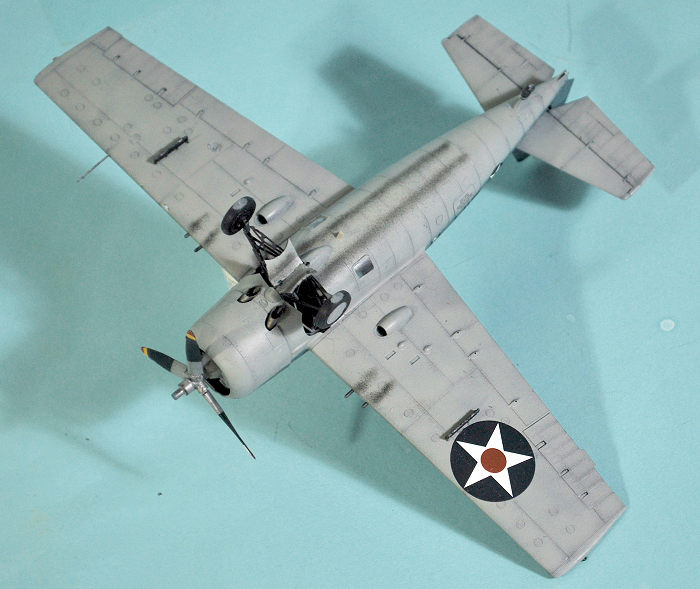 GQ sounded at
0500 hours on December 9. 45 minutes later the four Wildcats took off for the
dawn patrol, returning at 0730 hours to report seeing nothing. Putnam led two
Wildcats off at 1100 hours, followed by 2nd Lieutenant David Kliewer and
Sergeant Hamilton. The four were at 14,000 feet when 26 G3Ms were spotted at
13,000 feet. Kliewer and Hamilton managed to set one afire. As the bombers
closed, Batteries D and E opened fire. Twelve of 25 bombers were holed by
defending AA, but all returned successfully.
GQ sounded at
0500 hours on December 9. 45 minutes later the four Wildcats took off for the
dawn patrol, returning at 0730 hours to report seeing nothing. Putnam led two
Wildcats off at 1100 hours, followed by 2nd Lieutenant David Kliewer and
Sergeant Hamilton. The four were at 14,000 feet when 26 G3Ms were spotted at
13,000 feet. Kliewer and Hamilton managed to set one afire. As the bombers
closed, Batteries D and E opened fire. Twelve of 25 bombers were holed by
defending AA, but all returned successfully.
On December 10, the bombers arrived at 1045 hours. Elrod led the defending Wildcats in a dive through the formation. By the time he pulled out, two were headed for the ocean below, wings wrapped in fire.
On December 11, the Japanese invasion force arrived off Wake before dawn. At 0500 hours, the two light cruisers opened fire. With shells exploding around them, the four Wildcats lifted into the air. Each with two 100-pound bombs.
Yubari fired one broadside; Battery A replied with four salvoes. Two 5-inch shells hit the cruiser at a range of 6,000 yards. Yubari belched smoke and disappeared over the horizon.
The two destroyer-transports closed on Wilkes supported by three destroyers. Battery L took them on. At 0650 hours, the Marines’ third salvo caught the destroyer Hayate amidships. She exploded and broke in two - the first Imperial Navy ship sunk by U.S. forces in the Pacific War. Destroyer Oite made smoke to hide from the sharpshooting artillerymen, but was hit before the smoke hid her. Battery L then hit one of the destroyer-transports, which turned away and made smoke. At a range of 9,000 yards, Tatsuta took a hit from Battery L that forced her to withdraw. On Peale, Battery B engaged three destroyers and scored hits on Yayoi, which turned away followed by the others.
The Japanese were retreating when Putnam, Elrod, Freuler and Tharin strafed and bombed them. One of Freuler’s bombs hit the Kongo Maru and the other hit destroyer-transport Patrol Boat 33 was also hit. With the enemy in retreat, the Wildcats landed. Two were quickly refueled and rearmed. Kinney caught Kisaragi 20 miles offshore. His bomb hit her depth charges and she blew up at 0815 hours. Freuler’s Wildcat took hits in the engine with damage to the oil cooler and one cylinder; Elrod’s Wildcat took a hit from AA and crashed short of the runway, wrecking his plane. The defenders were down to two Wildcats.
Word of the successful defense electrified American newspapers. The Washington Post compared the Marines to the defenders of the Alamo. Sending a wave of pride through the country was the news the defenders had radioed “Send more Japs!” In fact, that was padding to the real message reporting half their equipment was destroyed and morale among the civilian workers was low.
30 G3Ms arrived four hours later. Davidson and Kinney attacked with Davidson shooting down two while Kinney downed a third; the AA batteries shot down a fourth and sent three heading south trailing smoke. Nevertheless, the defenses were again bombed.
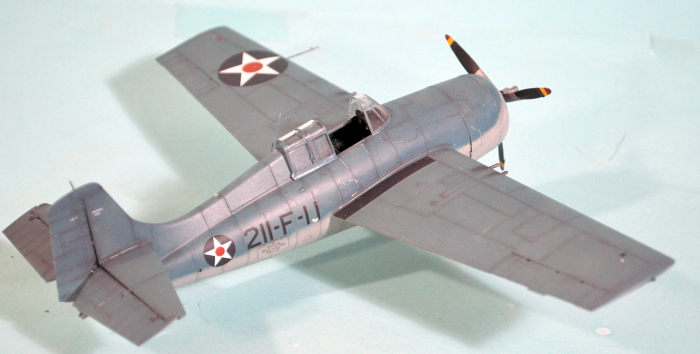 On
December 11, two H6K “Mavis” flying boats arrived at dawn. Flying solo patrol,
Tharin downed one while the other bombed the runway without effect. Kinney’s
trio managed to patch together another Wildcat from parts taken from the other
wrecks. There were now three defenders.
On
December 11, two H6K “Mavis” flying boats arrived at dawn. Flying solo patrol,
Tharin downed one while the other bombed the runway without effect. Kinney’s
trio managed to patch together another Wildcat from parts taken from the other
wrecks. There were now three defenders.
The enemy failed to show on December 13 but one Wildcat suffered a flat tire on takeoff and went off the runway, reducing the defense to two. The next morning, 30 G3Ms attacked and got a direct hit on one of the two Wildcats. Kinney’s crew rebuilt that Wildcat’s engine over the next two days; there were two again.
At Pearl Harbor, Saratoga’s task force arrived from San Diego that evening, carrying VMF-221's F2A-3s. By December 15, the seaplane tender Tangier took aboard the 4th Marine Defense Battalion, with 9,000 5-inch rounds, 12,000 3-inch rounds, and 3,000,000 .50-caliber rounds, as well as two radar sets and their operators.
Admiral Fletcheer’s Lexington Task Force 11 departed Pearl December 14 to make a diversionary raid on Jaluit in the Marshalls and provide cover to the relief mission. Saratoga’s Task Force 14 departed on December 15. Within a day, they were battling heavy seas in a midwinter storm, speed reduced so the old oiler Neches could keep up and provide fuel for the destroyers.
On December 17, Kinney’s crew brought two more Wildcats back from the graveyard. On December 19, 27 G3Ms arrived at 1050 hours. 20 minutes later, there were only four AA guns operational. Two Wildcats got airborne in time to remain safe and the bombers missed the other two. On December 20, a PBY landed in the lagoon, bringing word the relief convoy was expected to arrive in 72 hours. It left for Pearl at 0700 hours the next morning. Ninety minutes later, 29 D3As, escorted by 18 A6M2x, attacked, destroying the two newly-repaired Wildcats. Three hours later, 33 G3Ms destroyed all but one AA gun of Battery D.
The reported attack by carrier-based aircraft confirmed communications intelligence that the carriers Sōryū and Hiryū had been detached from the Mobile Fleet to support a second landing attempt. Vice Admiral William S. Pye, acting commander of the Pacific Fleet, canceled the Jaluit attack and ordered Task Force 11 to cover Task Force 14. There was concern a carrier battle could break out at any time. Both task forces experienced difficulty refueling their destroyers in the heavy seas, slowing progress even more. Task Force 14 still planned to arrive at Wake on December 23.
Freuler and Davidson were on patrol on December 22 when they spotted 33 B5Ns escorted by six Zeros, from Sōryū and Hiryū. Freuler shot down one B5N, then a second in a fight so close fragments damaged his controls. As he headed toward Wake a Zero closed on his tail and he saw Davidson for the last time, chasing a Zero with a second on his tail . A second Zero closed on Freuler and opened fire. Shot through the shoulder, he managed to crash land on the runway. Davidson was never seen again. The bomb aimer of the second B5N shot down was PO1/c Noburo Kanai, who dropped the bomb that blew up USS Arizona (BB-39).
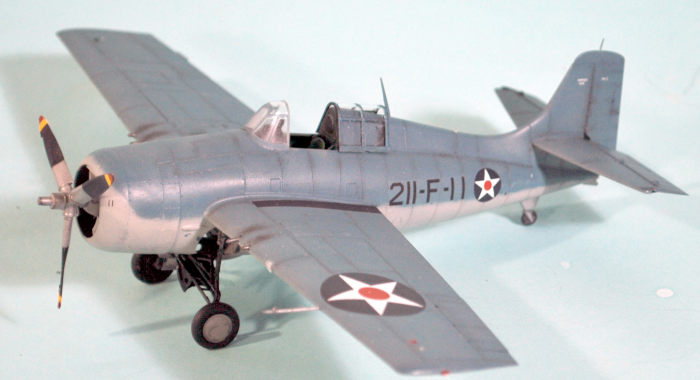 The 20
survivors of VMF-211 were issued rifles and ammunition.
The 20
survivors of VMF-211 were issued rifles and ammunition.
At Pearl Harbor, the report of the raid confirmed the presence of Japanese carriers. Admiral Pye could not risk two-thirds of his carriers and the Pacific Fleet’s remaining capital ships.
Saratoga was 427 miles from Wake at 0800 hours on December 22, when orders were received to return. Fletcher’s staff officers called for him to ignore the orders; he went below so he would not officially hear such “mutinous talk.” Marion Carl later recalled that the Marine pilots begged to be launched to fly in to Wake. Aboard Tangier, senior officers intervened to prevent the Marines from taking over the ship and sailing it to Wake in spite of orders. No one knew that at the time that four Japanese heavy cruisers were patrolling east of Wake without air cover, or that the fleet that arrived at dusk was disposed around the atoll with no security measures against surface attack. The outcome could have been different.
On Wake, the night of December 22-23 was stormy, with rain squalls and high seas. At 0200 hours on December 23 Tenryū and Tatsuta opened fire. At 0245 hours, Patrol Boats 32 and 33 ran through the reef and grounded on Wake. Flares fired from Peale illuminated them. Battery D hit Patrol Boat 33 14 times, killing seven and wounding 25. The Marines took Patrol Boat 32 under fire, lit by the explosion of Patrol Boat 33, but the 1,000 troopers of the Maizuru 2nd SNLF were ashore. The VMF-211 survivors, led by Putnam and Elrod, defended Battery D, which fell after 20 minutes of hard fighting; 62 Japanese and 14 of the 20 defending fliers were killed. “Hammerin’ Henry” Elrod was killed by a SNLF trooper hiding beneath a pile of casualties as he rose to throw a grenade.
The invaders 125 casualties before Commander Cunningham, seeing the American situation was hopeless, ordered Major Devereaux to surrender at 0700 hours. Fighting continued throughout the morning on Wilkes and Peale, where the gunners of Battery L made a final stand. Devereaux reached Wilkes at 1330 hours to find 25 Marines alive; they had killed all four Japanese officers and their 90 troops who landed that morning.
The Marines lost 49 killed, two missing, and 49 wounded during the 16-day siege of Wake. Three Navy personnel and at least 70 US civilians were killed, including the 10 Chamorro employees left behind by Pan American, with 12 civilians wounded; 433 Americans became Prisoners of War. Japanese losses were 140 SNLF troops and four sailors aboard ships. Three Japanese destroyers were sunk by artillery and aerial bombing along with both invasion vessels; 28 Japanese aircraft were shot down or damaged.
The next day, Christmas Eve of 1941, Saratoga was 180 miles south of Midway Island. Marion Carl and the other pilots of VMF-221 were launched to fly to the atoll.
| THE KIT |
There has been one other dedicated F4F-3 kit every released, that from Hobby Boss in 2007. This new kit from Eduard turns that kit into a door stop on any grounds other than price.
Eduard’s F4F-3 kit provides parts to make a model of any of the three production sub-types, which are distinguished by engine cowlings and a supercharger, all of which alternative parts are in the box. This is the first of a Wildcat series that will see the F4F-4 (arriving in October), the FM-1 and FM-2, as well as releases for FAA Martlets as part of Eduard’s “World War II at 80" program to release kits of the major fighter types used by both sides in the Pacific War between now and 2005.
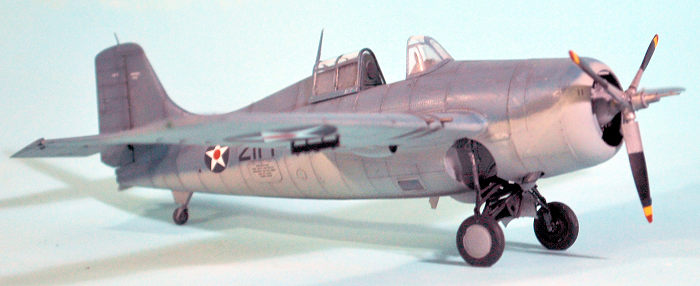 Unlike the
Hobby Boss and Tamiya F4Fs, the Eduard kit (and those to follow) has full detail
in the engine and wheel well, as well as complete dimensional accuracy - it
turns out the Tamiya F4F suffers a problem in comparison to the real thing
similar to that of the Trumpeter/Hobby Boss F6F series regarding shape outline.
Unlike the
Hobby Boss and Tamiya F4Fs, the Eduard kit (and those to follow) has full detail
in the engine and wheel well, as well as complete dimensional accuracy - it
turns out the Tamiya F4F suffers a problem in comparison to the real thing
similar to that of the Trumpeter/Hobby Boss F6F series regarding shape outline.
Decals are provided for six F4F-3s: a VF-41 “Yellow Wings” plane, an all-grey VMF-111 F4F-3A from the 1941 War Games, the VMF-211 Wildcat flown by Henry Elrod on his December 11 mission where he shot down two G3Ms, the publicity Wildcat “Butch” O’Hare sat in at the Grumman factory during his visit in April 1942, Lt. McCuskey’s F4F-3 in which he shot down the first plane by a Wildcat (mistakenly identified as being from VF-5 rather than VF-6 and at Midway rather than Kwajalein), and the F4F-3 flown by VMF-221's John Carey at Midway.
Fortunately, Yellow Wings Decals did early F4F-3s of VF-41 and VF-72, the Wake Island Wildcats, and Wildcats over Guadalcanal, and Fundekals has released an excellent sheet for F4F-3s and F4F-4s.
| CONSTRUCTION |
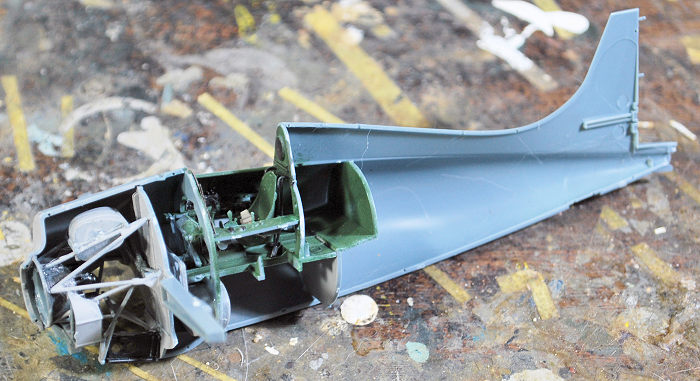 The only
“fiddly” part of the construction of this kit is in getting all the interior of
the wheel well positioned correctly. Take your time and all is well. Once you
have the wheel well and the cockpit installed, the fit of the two fuselage
halves is tight. I squeezed them together and glued an inch at a time, wrapping
the fuselage in rubber bands. After it set up overnight, there was no need for
any filler and the fuselage centerline seam disappeared under a light scraping.
The only
“fiddly” part of the construction of this kit is in getting all the interior of
the wheel well positioned correctly. Take your time and all is well. Once you
have the wheel well and the cockpit installed, the fit of the two fuselage
halves is tight. I squeezed them together and glued an inch at a time, wrapping
the fuselage in rubber bands. After it set up overnight, there was no need for
any filler and the fuselage centerline seam disappeared under a light scraping.
Past that, the rest is very easy: assemble and attach the wings - which I did with two rubber bands stratched wingtip to wingtip to press the wings tight to the fuselage. A spar is provided on which to mount the wings that assures proper dihedral. The horzontal stabilizer goes on easily. All the control surfaces fit tight, but you can droop the elevators if you wish (which I did). Fit overall is excellent and no filler of any kind was needed anywhere with careful assembly.
Modelers should note that all F4F-3s, being Grumman-built, had Bronze Green cockpits, with the area below the cockpit and the wheel well and firewall interior and cowling interior being light grey. All F4F-3s used lap belts only; the Navy didn’t equip airplanes with shoulder harnesses until after Coral Sea, just before Midway. The Profipack photoetch details provide everything the cockpit needs.
| COLORS & MARKINGS |
The Wake Island
Wildcats differ from the others. VMF-211 had not gotten their airplanes
repainted in the new camouflage of Blue-Grey upper surfaces and light grey lower
surfaces before they went aboard Enterprise on November 26, 1941, for transport
to Midway, being overall light grey still. While enroute, the upper surfaces
were spray painted Blue Grey, with the squadron identifiers repained from white
to black, and all stencils on the
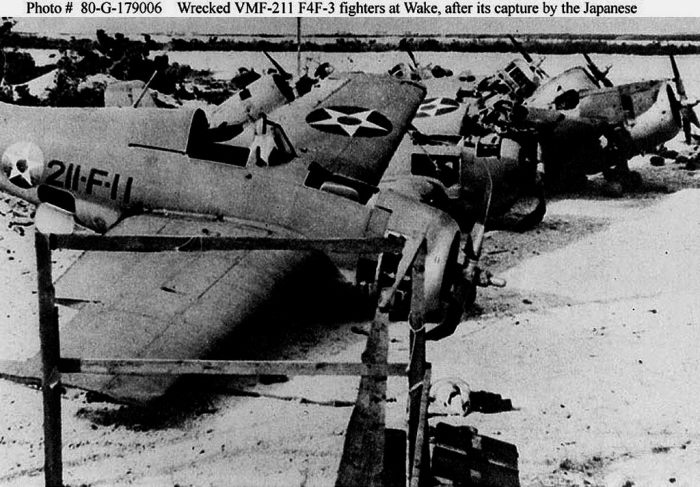 upper
surfaces overpainted and not replaced. The distinctive “upturned” nose scheme
was because the prop and front of the cowling were covered with tarpaulins while
the rest of the airplane was repainted. The one and only photo of the airplanes
- the “junkyard on Wake” photo, reveals to the careful viewer that no two were
exactly the same.
upper
surfaces overpainted and not replaced. The distinctive “upturned” nose scheme
was because the prop and front of the cowling were covered with tarpaulins while
the rest of the airplane was repainted. The one and only photo of the airplanes
- the “junkyard on Wake” photo, reveals to the careful viewer that no two were
exactly the same.
The Eduard decals are OK, but if you can get the Yellow Wings sheet, it is superior, being printed by Microscale. The sheet includes all eleven Wildcats (F-9 didn’t go aboard Enterprise because its engine wouldn’t start when they left Ford Island). F-1-7 were the seven destroyed on December 8, while F-8, 10, 11, and 12 were the four lost and rebuilt during the battle.
The air battle only lasted 14 days in cloudy, winter skies; thus paint fading and wear is not a feature of a Wake Island Wildcat. Even the “junkyard photo” reveals the airframes are not in bad shape paint-wise. I chose to do F-11, the plane Elrod flew on December 11(and may have flown the preceding days)since it would not have been the subject of a lot of airframe rebuilding, which might have put “dings” on the others that can’t be verified since the Marines were selfishly busy fighting a war and unable to do their duty and take photos for the use of modelers 80 years later. The Yellow Wings decals went down without trouble. Had I not had this sheet, I would have used the Eduard sheet and I am sure from experience it would have been fine.
After giving the model an overall coat of clear flat, I unmasked the canopy and lower windows. I then attached the wing nav lights after painting them clear red and clear green; these all have a litle mounting tab that makes them very easy to use - I hope Eduard continues this. I mounted the main landing gear, which is much easier than it appears at first. I then attached the prop, glued the canopy open, and called it done.
| CONCLUSIONS |
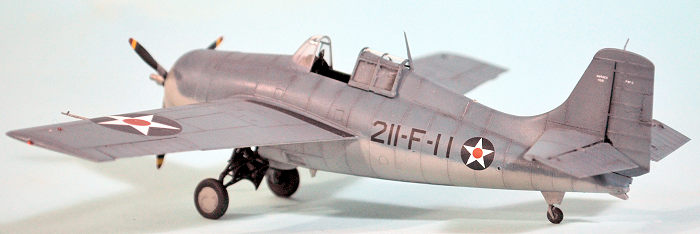 Every time
Eduard comes out with a new kit, I look at it and say “They can’t top this!” at
which point Vlad Sulc taps my shoulder and says “Hold my Pilsener please,” and
they go top themselves. This kit has superb detail throughout. The “fatal flaw”
- slightly-raised gun bay covers - that the Easily Upset over at The Other Place
were obsessing over, turns out to be only noticeable if you run your fingertip
over the panel line. The rivets are also so “scale” they are not noticeable at a
distance fursther than 3-4 inches - just like the rivets on a real Wildcat are
invisible past about 3 feet. The panels on the fuselage are lapped and do not
have the “boiler rivets” of the Tamiya kit, thanks to molding advances in the
past 30 years.
Every time
Eduard comes out with a new kit, I look at it and say “They can’t top this!” at
which point Vlad Sulc taps my shoulder and says “Hold my Pilsener please,” and
they go top themselves. This kit has superb detail throughout. The “fatal flaw”
- slightly-raised gun bay covers - that the Easily Upset over at The Other Place
were obsessing over, turns out to be only noticeable if you run your fingertip
over the panel line. The rivets are also so “scale” they are not noticeable at a
distance fursther than 3-4 inches - just like the rivets on a real Wildcat are
invisible past about 3 feet. The panels on the fuselage are lapped and do not
have the “boiler rivets” of the Tamiya kit, thanks to molding advances in the
past 30 years.
If you like the Wildcat, this is the model for you. There will definitely be more than one of each sub-type here at Le Chateau du Chat. Highly recommended.
25 August 2022
Copyright ModelingMadness.com. All rights reserved. No reproduction in part or in whole without express permission.
Review kit courtesy of Eduard.
If you would like your product reviewed fairly and fairly quickly, please contact the editor or see other details in the Note to Contributors.